Mexicans will be able to use a central bank-issued digital currency later this decade, the federal government said Wednesday.
President López Obrador’s office said in a Twitter post that the Bank of México (Banxico) had reported that it will put its own digital currency into circulation by 2024.
However, Banxico sources cited by the newspaper Milenio said the bank had not published any document on the subject.
The president’s office said the central bank considers “new technologies and state-of-the-art payment infrastructure” to be of “utmost importance” due to their capacity to “advance financial inclusion.”
According to the financial website Investopedia, a central bank digital currency, or CBDC, is a virtual form of a fiat currency – a government-issued currency that is not backed by a physical commodity such as gold or silver.
“A CBDC is an electronic record or digital token of a country’s official currency. As such, it is issued and regulated by the nation’s monetary authority or central bank,” Investopedia said.
“… CBDCs can simplify the implementation of monetary and fiscal policy and promote financial inclusion in an economy by bringing the unbanked into the financial system.”
The Bahamas and Nigeria are the only countries to have already launched CBDCs but more nations are expected to follow suit in the coming years.
The announcement of Banxico’s CBDC plans comes just two months after the launch of a blockchain-based currency – the hoozie – that can be used in the Guadalajara metropolitan area.
The world’s best known blockchain-based currency, Bitcoin, and other crypto-currencies are not legal tender in Mexico, but one recent survey shows that just over 12% of Mexican adults have invested in them.
Earlier this month, Elektra became the first chain of retail stores in Mexico to accept bitcoin. Its billionaire owner, Ricardo Salinas, is a Bitcoin enthusiast. He indicated his support for the CBDC plan by responding to the government’s Twitter post with a smiley face emoji.
With reports from Milenio
